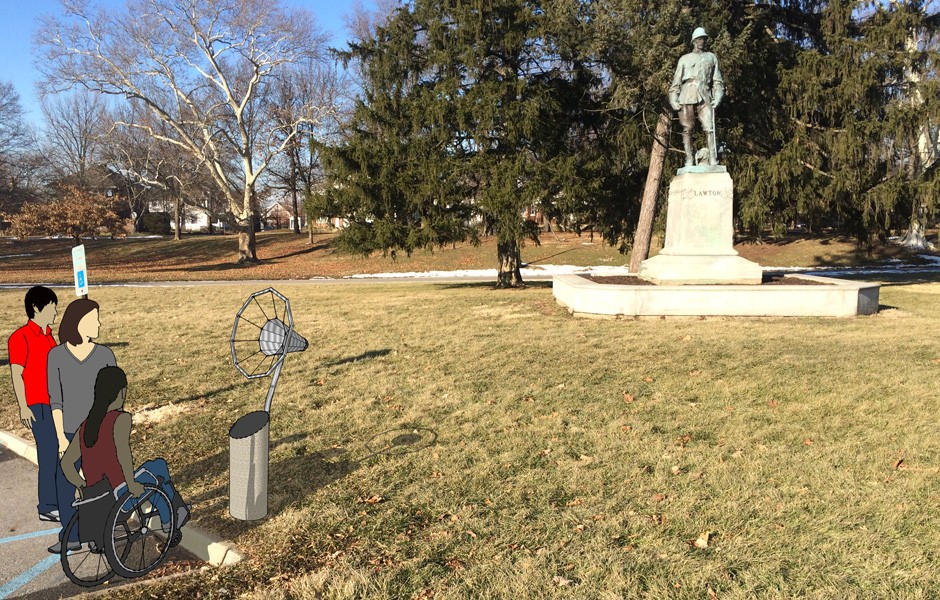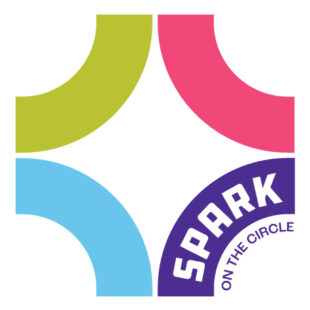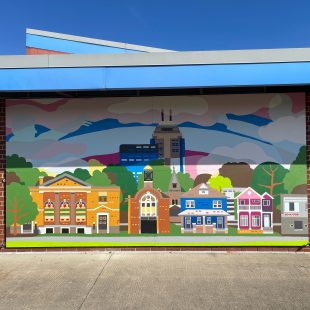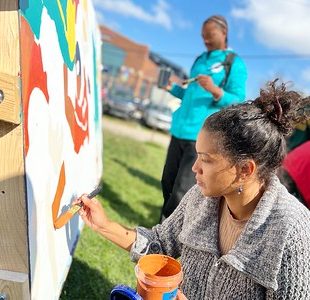Edit on June 10, 2020 following to the much-needed removal of the confederate maker at Garfield Park that was one stop on the Friends of Garfield Park audio tour. While the original text we wrote in 2015 remains below, here’s an update and background we didn’t share before (as we should have).
First, an apology. We made a mistake by being involved in a project that we couldn’t control with a partner who broke our trust. We apologize for being part of a project that we didn’t fully vet — especially one that involved aspects that require the kind of depth of consideration, thought, and compassion as the confederate marker. This decision was made seven years ago and we learned from it as we continue to learn from our mistakes today.
Some factual history: In 2013, Big Car Collaborative, based in the Garfield Park neighborhood, was asked by Friends of Garfield Park (not Indy Parks) to help with an educational project. We were commissioned to design markers that went at various sites — the pagoda, the performing art center, the sunken gardens, and other locations that included the confederate marker. The locations were chosen by Friends of Garfield Park, a separate nonprofit organization not affiliated with Big Car and not part of city government or part of the Indianapolis parks department. We were paid $8,000 from funds from a grant made to the Friends of Garfield Park for the historic audio tour by the Indianapolis-based Nina Mason Pulliam Charitable Trust.
We designed the metal markers explained below to provide audio for phones as people walked and to share what number to call and a small bit of information. We designed these without signage or text. Big Car was not part of researching or writing the history of the audio tour, recording the tour, designing the tour, or any aspect of how the history or information was shared. While the original promise was that we would be involved, we ended up having no say in the text. All of the text was provided by Friends of Garfield Park staff.
When the text was completed and the audio recorded, we strongly objected to the handling of both the confederate marker and the Lawton monument. And we fought against the text by stating our concerns with the Friends of Garfield Park staff and board leadership.
At that point, the text was not changed the way we wanted it to be. But we had no control over the project. It was not ours. We were a partner on the design of the small functional marker sculptures for the tour. And that was all we were able to control.
In 2015, we heard from DJ Kyle Long who had worked with us many times before — including collaborating with us on events at Service Center (full photo set here) with the international community and participating as our musical curator in TEDxIndianapolis events. He offered to help connect someone who could write a better history with Friends of Garfield Park. And we made that connection.
We were never in favor of the way these monuments were handled with this audio tour. And we fought again with the Friends of Garfield Park staff when changes weren’t made after Kyle got involved. We then removed the markers we designed at both of these monuments. This resulted in a battle leading to potential legal ramifications for us. And we returned the markers.
We were removed as being listed as a partner on the project. We are not listed anywhere on the Friends of Garfield Park page for this tour. We kept this page on our website because we did do this design work. This section of our website documents all of the work we do. We have not tried to hide that we were part of the design of the markers.
An additional mistake we made was not previously sharing what happened and acknowledging that we we were wrong to be part of this in the first place — even if only as designers. We knew that we had made a mistake very early in this partnership. We regret our involvement.
There is no doubt about this: For everyone at Big Car Collaborative, our strong preference has always been for the confederate marker and Lawton monument to be removed from the park. We have never defended it, glorified it, or said anything other than it should go. We never believed monuments to hate and war made sense in our park or neighborhood or anywhere else.
If you don’t know the history of the confederate marker, this article by Garfield Park neighbor Laura McPhee is helpful.
Here’s our brief statement on the marker from June 7, 2020: The City of Indianapolis has removed the out-of-context confederate grave marker brought to Garfield Park for racist and divisive reasons. It made no sense being here. No soldiers died in Garfield Park. They are buried in Crown Hill Cemetery, which didn’t want this marker either. Worst of all, it stood at the entrance to our park as a sign of hate and exclusion. This isn’t Garfield Park now. All are welcome. So what’s next? It’s time to learn, to listen, to be considerate. It’s also time to act. Let’s work together to further support our community as a place for everyone. This process should be led by and involve Black artists.
And here’s our statement on racial justice and police brutality (first shared June 1, 2020):
As we always did, we stand with the Black community. We stand with protestors and stand against police brutality. We stand for freedom and stand against injustice. We reject responses that limit freedom. We reject responses that don’t acknowledge the damage caused by racism ingrained in our criminal justice system — and in American society. We support efforts that bridge justified rage and dialogue into systemic change. We will listen, learn, reflect, take action, and be accountable. We acknowledge that we work within and have benefited from systemic racism. We will improve. We will support community. We will create spaces that help us see one another and ourselves and imagine a future that rebuilds and heals. We are grateful for each of you. Black lives matter.
Visit other project pages on this website for many examples of our work that show this longtime commitment. Here are some places to start (all led or co-led by director of programs and exhibitions, Shauta Marsh):
Commissioned Mari Evans mural and Carl Pope exhibition.
Pablo Helguera’s Liberia Donceles at Listen Hear.
LaShawnda Crowe Storm and Maria Hamilton Abegunde exhibition and related programming.
Laura Ortiz Vega exhibition and related programming.
Yvette Mayorga exhibition and related programming.
Casey No and Taylor Rose exhibition and related programming.
Artist and Public Life Residency affordable housing program.
——
Original unedited project information posted here since 2015:
We were commissioned by the Friends of Garfield Park in 2014, as part of the Garfield Alive! program (funded by the Nina Mason Pulliam Charitable Trust), to design a series of markers to highlight some of Garfield Park’s major points of interest.
It was a fascinating challenge, to design a piece for anyone who might happen upon it, that speaks both to the heritage of the park and the park’s present and future visitors – for decades (and even centuries) to come.
At a sprawling 128 acres, there are assets in the park of which even regular visitors are not aware. The vista markers aim to engage visitors by calling attention to important park features from afar and also providing relevant information, in both visual and auditory form, upon closer investigation.
Visitors who encounter these vista markers, with shapes abstracted from classic Victrola-style phonograph players, are prompted to dial a phone number unique to each marker that will launch an audio history about the relevant park feature. Upon dialing in, visitors can place their phones inside the open cylinders of each marker to take advantage of the natural amplification provided by the shape of the metal. This amplification allows multiple visitors to share the experience simultaneously – it’s a working, no-electricity speaker!
About Garfield Park
Garfield Park, flanking downtown’s southern edge, is the oldest city park in Indianapolis. An essential part of noted landscape architect George Edward Kessler’s Park and Boulevard Plan for the city, it is also on the National Register of Historic Places.
About iFab: Vista Fabricators
An exciting part of this project for Big Car was the opportunity to work with iFAB.
Indianapolis Fabrications is a custom fabrication company specializing in unique or small run projects. They specialize in fine art fabrication, prototyping, limited run custom design products, art conservation and restoration and vintage automobile restoration and customization.
Projects of note include:
- the largest artwork in Indianapolis, “May/September,” a 13,000 sq ft metal sculpture on the facade of the New Wishard Hospital
- PUPstop Stadium Chairs / The Bush Stadium Seat Salvage Project
- Mary Miss’ “Flow Can You See The River” – 200 sites across Indianapolis




